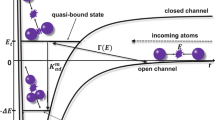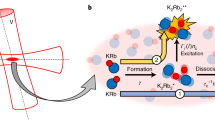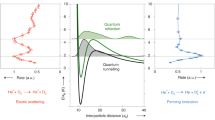Abstract
Three-body recombination is a collision process where two atoms combine to form a molecule and a third atom carries away part of the released reaction energy. Here, we experimentally determine for the first time the population distribution of the molecular reaction products after a three-body recombination for non-resonant particle interactions. The key to our measurements is a sensitive detection scheme that combines the photoionization of the molecules with subsequent ion trapping. Using an ultracold 87Rb gas at very low kinetic energy below h×20 kHz, we find a broad population of final states with binding energies of up to h×750 GHz. This is in contrast with previous experiments, performed in the resonant interaction regime, that found a dominant population of only the most weakly bound molecular state or the occurrence of Efimov resonances. This work may contribute to the development of an in-depth model that can qualitatively and quantitatively predict the reaction products of three-body recombination.
This is a preview of subscription content, access via your institution
Access options
Subscribe to this journal
Receive 12 print issues and online access
$209.00 per year
only $17.42 per issue
Buy this article
- Purchase on Springer Link
- Instant access to full article PDF
Prices may be subject to local taxes which are calculated during checkout





Similar content being viewed by others
References
Hess, H. F. et al. Observation of three-body recombination in spin-polarized hydrogen. Phys. Rev. Lett. 51, 483–486 (1983).
Burt, E. A. et al. Coherence, correlations, and collisions: What one learns about Bose–Einstein condensates from their decay. Phys. Rev. Lett. 79, 337–340 (1997).
Söding, J. et al. Three-body decay of a rubidium Bose–Einstein condensate. Appl. Phys. B 69, 257–261 (1999).
Esry, B. D., Greene, C. H. & Burke, J. P. Recombination of three atoms in the ultracold limit. Phys. Rev. Lett. 83, 1751–1754 (1999).
Suno, H. & Esry, B. D. Three-body recombination in cold helium–helium-alkali-metal-atom collisions. Phys. Rev. A 80, 062702 (2009).
Wang, Y., D’Incao, J. P. & Esry, B. D. Cold three-body collisions in hydrogen–hydrogen-alkali-metal atomic systems. Phys. Rev. A 83, 032703 (2011).
Guevara, N. L., Wang, Y. & Esry, B. D. New class of three-body states. Phys. Rev. Lett. 108, 213202 (2012).
Fedichev, P. O., Reynolds, M. W. & Shlyapnikov, G. V. Three-body recombination of ultracold atoms to a weakly bound s level. Phys. Rev. Lett. 77, 2921–2924 (1996).
Bedaque, P. F., Braaten, E. & Hammer, H-W. Three-body recombination in Bose gases with large scattering length. Phys. Rev. Lett. 85, 908–911 (2000).
Efimov, V. Energy levels arising from resonant two-body forces in a three-body system. Phys. Lett. B 33, 563–564 (1970).
Braaten, E. & Hammer, H-W. Three-body recombination into deep bound states in a Bose gas with large scattering length. Phys. Rev. Lett. 87, 160407 (2001).
Kraemer, T. et al. Evidence for Efimov quantum states in an ultracold gas of caesium atoms. Nature 440, 315–318 (2006).
Weber, T., Herbig, J., Mark, M., Nägerl, H-C. & Grimm, R. Three-body recombination at large scattering lengths in an ultracold atomic gas. Phys. Rev. Lett. 91, 123201 (2003).
Jochim, S. et al. Pure gas of optically trapped molecules created from Fermionic atoms. Phys. Rev. Lett. 91, 240402 (2003).
Simoni, A. & Launay, J-M. Ultracold atom-molecule collisions with hyperfine coupling. Laser Phys. 16, 707–712 (2006).
Bates, D. R., Kingston, A. E. & McWhirter, R. W. P. Recombination between electrons and atomic ions. I. Optically thin plasmas. Proc. R. Soc. Lond. Ser A. 267, 297–312 (1962).
Flower, D. R. & Harris, G. J. Three-body recombination of hydrogen during primordial star formation. Mon. Not. R. Astronom. Soc. 377, 705–710 (2007).
Lozeille, J. et al. Detection by two-photon ionization and magnetic trapping of cold Rb2 triplet state molecules. Eur. Phys. J. D 39, 261–269 (2006).
Fioretti, A. et al. Formation of cold Cs2 molecules through photoassociation. Phys. Rev. Lett. 80, 4402–4405 (1998).
Gabbanini, C., Fioretti, A., Lucchesini, A., Gozzini, S. & Mazzoni, M. Cold rubidium molecules formed in a magneto-optical trap. Phys. Rev. Lett. 84, 2814–2817 (2000).
Huang, Y. et al. Formation, detection and spectroscopy of ultracold Rb2 in the ground X1Σg+ state. J. Phys. B 39, S857–S869 (2006).
Salzmann, W. et al. Coherent transients in the femtosecond photoassociation of ultracold molecules. Phys. Rev. Lett. 100, 233003 (2008).
Sullivan, S. T. et al. Trapping molecular ions formed via photo-associative ionization of ultracold atoms. Phys. Chem. Chem. Phys. 13, 18859–18863 (2011).
Mudrich, M. et al. Spectroscopy of triplet states of Rb2 by femtosecond pump–probe photoionization of doped helium nanodroplets. Phys. Rev. A 80, 042512 (2009).
Strauss, C. et al. Hyperfine, rotational, and vibrational structure of the a3Σu+ state of 87Rb2 . Phys. Rev. A 82, 052514 (2010).
Takekoshi, T. et al. Hyperfine, rotational, and Zeeman structure of thelowest vibrational levels of the 87Rb2 (1) 3Σg+ state. Phys. Rev. A 83, 062504 (2011).
Drozdova, A. Study of Spin-Orbit Coupled Electronic States of Rb 2 , NaCs and NaK Molecules. Laser Spectroscopy and Accurate Coupled-channel Deperturbation Analysis PhD thesis, Univ. de Lyon and Lomonosov State Univ. (2012).
Mukaiyama, T., Abo-Shaeer, J. R., Xu, K., Chin, J. K. & Ketterle, W. Dissociation and decay of ultracold sodium molecules. Phys. Rev. Lett. 92, 180402 (2004).
Staanum, P., Kraft, S. D., Lange, J., Wester, R. & Weidemüller, M. Experimental investigation of ultracold atom-molecule collisions. Phys. Rev. Lett. 96, 023201 (2006).
Zahzam, N., Vogt, T., Mudrich, M., Comparat, D. & Pillet, P. Atom-molecule collisions in an optically trapped gas. Phys. Rev. Lett. 96, 023202 (2006).
Quéméner, G., Launay, J-M. & Honvault, P. Ultracold collisions between Li atoms and Li2 diatoms in high vibrational states. Phys. Rev. A 75, 050701 (2007).
Schmid, S., Härter, A., Frisch, A., Hoinka, S. & Hecker Denschlag, J. An apparatus for immersing trapped ions into an ultracold gas of neutral atoms. Rev. Sci. Instrum. 83, 053108 (2012).
Schmid, S., Härter, A. & Hecker Denschlag, J. Dynamics of a cold trapped ion in a Bose–Einstein condensate. Phys. Rev. Lett. 105, 133202 (2010).
Härter, A. et al. Single ion as a three-body reaction center in an ultracold atomic gas. Phys. Rev. Lett. 109, 123201 (2012).
Aymar, M., Azizi, S. & Dulieu, O. Model-potential calculations for ground and excited Σ states of Rb2+, Cs2+ and RbCs+ ions. J. Phys. B 36, 4799–4812 (2003).
Acknowledgements
The authors would like to thank S. Schmid and A. Brunner for support during early stages of the experiment and O. Dulieu, B. Esry, J. d’Incao, W. Stwalley, U. Heinzmann, J. Hutson, P. Soldan, T. Bergeman and A. Drozdova for valuable information and fruitful discussions. This work was supported by the German Research Foundation DFG within the SFB/TRR21.
Author information
Authors and Affiliations
Contributions
A.H. and A.K. performed the experiments in the atom–ion trap set-up; M.D. and B.D. performed spectroscopic measurements on Rb2 molecules; A.H., A.K., E.T. and J.H.D. analysed data; A.H., E.T. and J.H.D. wrote the paper.
Corresponding author
Ethics declarations
Competing interests
The authors declare no competing financial interests.
Supplementary information
Supplementary Information
Supplementary Information (PDF 422 kb)
Rights and permissions
About this article
Cite this article
Härter, A., Krükow, A., Deiß, M. et al. Population distribution of product states following three-body recombination in an ultracold atomic gas. Nature Phys 9, 512–517 (2013). https://doi.org/10.1038/nphys2661
Received:
Accepted:
Published:
Issue Date:
DOI: https://doi.org/10.1038/nphys2661
This article is cited by
-
Laser-induced forced evaporative cooling of molecular anions below 4 K
Nature Physics (2023)
-
Roaming pathways and survival probability in real-time collisional dynamics of cold and controlled bialkali molecules
Scientific Reports (2021)
-
Mass-selective removal of ions from Paul traps using parametric excitation
Applied Physics B (2020)
-
The derivation of the \(\mathbb {T}^{3}\) T 3 energy-critical NLS from quantum many-body dynamics
Inventiones mathematicae (2019)
-
Universal dynamics of a degenerate unitary Bose gas
Nature Physics (2014)



